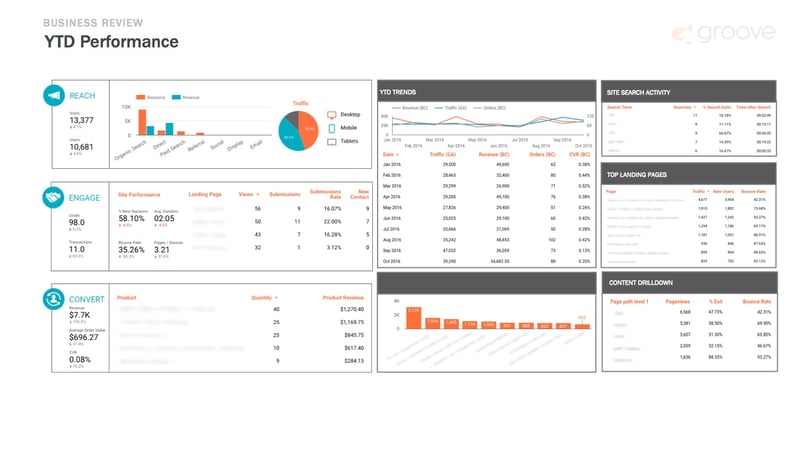In today’s digital space, the amount of information, data, and analytics available can be daunting to anyone trying to make sense of it.
As the Chief Client Officer here at Groove, it is my responsibility to make sure that each of our marketing clients is achieving success in both the short term and the long term. With 15 clients in a variety of sizes and a range of industries, it would be easy for me to inundate myself with data and become paralyzed with analysis – classic paralysis analysis.

To avoid this, we provide a tailored monthly executive summary that highlights both the goal metrics (revenue, traffic, conversion, etc.) as well as a breakdown of the elements that roll-up to drive those metrics (source data, visitor journey’s, landing pages, etc.). The most important thing to establish early is – what does success look like – and agree on what actually builds that success.
As a CEO, let’s agree that the true focus of your combined marketing and sales team is always going to be driving revenue growth. While the amount of revenue growth or the pace is always specific to your organization, at its core, marketing should always align to revenue.
That being said, the gap between a website visitor, event visitor, email reader, social subscriber, and the ultimate almighty dollar may never be a completely closeable loop due to disparate systems and non-communicative technology.
So you shouldn’t be specifically focused on how the marketing contributes to revenue, as I’m certain you have smart people driving those decisions. However, your role as the CEO is to hold the team accountable and ensure success.
In my role, I review most client’s monthly activities only one or two times a month, first to see how we are pacing against goal for the short term and then to see how we did against stated objectives.
As it relates to metrics, my focus should be on two things:
How close were we to target for our top line goal and how are we pacing against the bigger picture (quarter, year, 12-month rolling average)?, and
How did our top channels/sources of success perform against the previous period?
3 Metrics to Look at on a Regular Basis:
Revenue Goal: How are we pacing against our agreed-to target?
Revenue goals should be present and top of mind at all times. What is the stated revenue goal that marketing is responsible for annually? If marketing doesn’t break this out – then how is the entire organization doing and does marketing know this?
- What was our actual revenue for this time period? (Monthly/Quarterly/Rolling 90-days)
- What was the goal for this interval of time?
- What % of that goal have we achieved?
- Pacing – what should we have achieved thus far this year based on historical performance? Seasonality?
Reach: How many people did we communicate our message to?
Visitors:
- What is our trending (I use 90-day rolling) website visitors number?
- Compared to last year?
- Up or down over last month?
Users:
- How many users did it take to get to visitors number? Trending up or down?
Conversions: How well are we doing at turning visitors into customers/leads?
- What is our current conversion rate? Is this up or down over the last 30-days?
- How many actual conversions/transactions did we create?
- Side note: In the case of leads vs sales I ask the team to provide me with both leads in the month and ultimately transaction number. As one is a leading indicator of the other.
You should notice that I do not initially pay attention to traffic by source (Social/Email/Paid/etc.) or specific areas of website/pages. If the health of the numbers is in the green then marketing is doing its job.
Should I see anything that is trending behind or has shown a history of downward performance, the report inherently allows me to ask questions to gain deeper insight to alleviate concern. This ensures that what the team reports to me isn’t about checking boxes but remains focused on driving revenue.
As a side note – my reports are visual in nature – showing 12-month time intervals and layering Visits, Transactions, and Revenue on top of each other so I can see the relationship between each. I would recommend that every CEO ask your team build a visual dashboard with executive summary details to make it easy to digest.
 With the right reports in front of you, you'll be able to make better decisions about the health and future of your business.
With the right reports in front of you, you'll be able to make better decisions about the health and future of your business.

E-BOOK
20 Best Shopify Apps For Your eCommerce Store
Explore tags:
About the author
Subscribe to the Groove Newsletter
Get the latest updates and insights straight to your inbox


